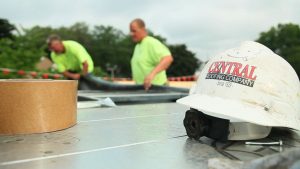Central Roofing Company was founded in 1929 in Fridley, Minnesota (where we are still headquartered). Legend has it that the company was founded by a banker who needed new income when the stock market famously crashed, ushering in the Great Depression. That’s a story for another day — this post is about roofing’s staple material: asphalt shingles.
Asphalt shingles were first used in 1901 in the United States. By 1911, people started to use them on a general scale, and by 1939, approximately 11 million were being produced. The precursor versions of these shingles were initially developed in 1893 and were referred to as asphalt prepared roofing, which was rather similar to asphalt roll roofing but with no surface granules. In 1987, there was the addition of slate granules to the surface to make the material a whole lot more durable. Some of the granules tested included oyster shells, mica, fly-ash, slate, clay, and silica. Finally, the material was cut into strips in 1901 for use as single-tab and multi-tab shingle.
Initially, all shingles had an organic base material called felt, which was largely made of cotton up to the 1920s when it became too expensive and an alternative material had to be found, some of which included jute and wood pulp. In 1926, the Research Institute with NBS (National Bureau of Standards) and Asphalt Shingle tested 22 kinds of experimental felts and discovered that there were no substantial differences in performance.
During the 1950s, manually applied and self-sealing adhesives started to be used in order to prevent the damage caused by wind to shingle roofs. A standard was set for the self-sealing strips of adhesives to be totally adhered after 16 hours at 140 degrees Fahrenheit. The 1950s also saw the testing of 3/4 inch staples, which revealed that they could perform as well as nails. However, this was only achievable with 6 staples and not 4 nails as people were used to.
Fiberglass mat bases were introduced in 1960 but experienced minimal success. These lighter and more flexible shingles were found to be more susceptible to wind damage, especially at freezing temperatures. In addition, research done in the same year showed that they were also prone to hail damage when faced with sizes larger than 1.5 inches. In 1990, the Asphalt Roofing Manufacturers Association (ARMA) created a High Wind Task Force to continue with the research on how to shingle wind resistance.
Today, Central Roofing Company is a commercial roofing contractor with nationwide reach. We install all types of roofing systems — steep slope (shingle) roofs included. Although shingles are not the most prevalent material used to complete our projects today, we salute our industry’s history. No doubt we wouldn’t be Central Roofing Company without appreciation for our trade tools.






